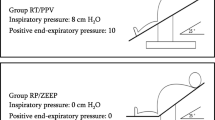Background: Hypoxemia during the induction of general anesthesia for the morbidly obese patient is a major concern of anesthesiologists. The etiology of this pathophysiological problem is multifactorial, and patient positioning may be a contributing factor. The present study was designed to identify optimal patient positioning for the induction of general anesthesia that minimizes the risk of hypoxemia in these patients. Methods: 26 morbidly obese patients (body mass index - BMI 56±3) were randomly assigned to one of three positions for induction of anesthesia: 1) 30° Reverse Trendelenburg; 2) Supine-Horizontal; 3) 30° Back Up Fowler. Mask ventilation, full neuromuscular paralysis and direct laryngoscopy were performed. Any airway difficulties were noted. After endotracheal tube placement, subjects were ventilated for 5 minutes with 1% isoflurane in a mixture of 50% oxygen / 50% air and then disconnected from the ventilation circuit.The time required for capillary oxygen saturation (SaO2), as measured by pulse oximeter, to decline from 100% to 92% was noted and identified as the safe apnea period (SAP). Ventilation was then immediately re-established.The lowest SaO2 after resuming ventilation and the time from that nadir to an SaO2 of 97% were also recorded. Results: BMI and hip-waist ratios of patients in groups 1, 2 and 3 did not significantly differ. There were no differences in airway difficulties between the different groups. The SAP in groups 1, 2 and 3 was 178±55, 123±24 and 153±63 seconds, respectively. The SaO2 of patients in the reverse Trendelenburg position dropped the least and took the shortest time to recover to 97%. Conclusions: In morbidly obese patients, the 30° Reverse Trendelenburg position provided the longest SAP when compared to the 30° Back Up Fowler and Horizontal-Supine positions. Since on induction of general anesthesia morbidly obese patients may be difficult to mask ventilate and/or intubate, this extra time may preclude adverse sequelae resulting from hypoxemia. Therefore, Reverse Trendelenburg is recommended as the optimal position for induction.
Similar content being viewed by others
Author information
Authors and Affiliations
Rights and permissions
About this article
Cite this article
Boyce, J.R., Ness, T., Castroman, P. et al. A Preliminary Study of the Optimal Anesthesia Positioning for the Morbidly Obese Patient. OBES SURG 13, 4–9 (2003). https://doi.org/10.1381/096089203321136511
Published:
Issue Date:
DOI: https://doi.org/10.1381/096089203321136511



